

Behind the tour: Farnsworth House

Each year, CAC staff and our team of more than 450 dedicated docents work together to create new ways to experience architecture. But have you ever wondered what inspires our tours? Here’s the story behind our Farnsworth House bus tours.
by Kerstin Adams, Marketing Manager
WHAT IS FARNSWORTH HOUSE?
The iconic Farnsworth House was built along the banks of the Fox River in 1951 as a country retreat for Dr. Edith Farnsworth. It’s one of the most significant of Mies van der Rohe’s works and among the world’s great architectural masterpieces. A founder and leader of the modernist movement in Europe, Mies lived and worked in Chicago for more than 30 years. He is well known for his use of glass and steel, as well as his sleek design aesthetic and the “less is more” philosophy that influenced city skylines around the world.
WHY IS IT SIGNIFICANT?
The Farnsworth House is a direct reflection of Mies’ signature approach and an exemplary representation of the International Style . The design is striking: pure white concrete slabs line the floor-to-ceiling glass walls, opening the space up to the house’s surrounding elements. As Mies explained, “We must beware not to disrupt [nature] with the color of our houses and interior fittings. Yet we should attempt to bring nature, houses and human beings together into a higher unity.”
The design of the house was so acclaimed that a 1947 exhibition of Mies’ work at the Museum of Modern Art included a model of the Farnsworth House before it was even built. Since then, the house has been included in the National Register of Historic Places (2004) and designated a National Historic Landmark (2006).
HOW DID IT OPEN UP TO THE PUBLIC?
In 1972, Dr. Edith Farnsworth sold Farnsworth House to Baron Peter Palumbo, a British arts patron who had restored several other historic properties. When Palumbo listed the building for sale at Sotheby’s auction house in 2003, several potential buyers inquired about dismantling the structure and moving it to another state. In an attempt to keep the house intact and in its intended location, Landmarks Illinois, the National Trust for Historic Preservation and the Friends of the Farnsworth House purchased the building at auction and opened it to the public as a house museum.
WHY THE FARNSWORTH HOUSE TOUR?
Shortly after its public opening, CAC received several requests from private groups to organize tours of this architectural masterpiece. CAC docents and staff realized that this significant site—and its architect, who had such an immense impact on the world of design—ought to be introduced to the greater public.
In 2005, docent Bill Shapiro developed the Farnsworth House PLUS tour as a celebration of the career of Mies van der Rohe, the influential architect who introduced Modernism to Chicago. The tour starts at 860–880 North Lake Shore Drive for a look at the two towers that helped define Chicago as a leader in Mid-Century Modern architecture. From there, the tour continues to Crown Hall at the Illinois Institute of Technology (IIT), which is widely considered to be Mies’ finest work. Finally, guests enjoy a guided tour of Farnsworth House. In 2013, CAC launched a second Farnsworth House tour for guests who are simply interested in visiting the iconic house.
EXPLORE WITH US
Both Farnsworth House tours attract architecture enthusiasts from around the world who want to see one of the leading Mid-Century Modern architecture sites. Expand your knowledge of Mies’ career beyond the Loop, and experience this vital part of American iconography in person.
The Farnsworth House tour and Farnsworth House PLUS tour depart on select Thursdays and Sundays at 9:30am.

Take the Tour
Farnsworth house.
Discover Mies van der Rohe’s modernist masterpiece with our Farnsworth House and Farnsworth House PLUS tours.
You are using an outdated browser. Please upgrade your browser to access savingplaces.org.
National Trust for Historic Preservation: Return to home page
Site navigation, america's 11 most endangered historic places.
This annual list raises awareness about the threats facing some of the nation's greatest treasures.
Join The National Trust
Your support is critical to ensuring our success in protecting America's places that matter for future generations.
Take Action Today
Tell lawmakers and decision makers that our nation's historic places matter.
Save Places
- PastForward National Preservation Conference
- Preservation Leadership Forum
- Grant Programs
- National Preservation Awards
- National Trust Historic Sites
Explore this remarkable collection of historic sites online.
Places Near You
Discover historic places across the nation and close to home.
Preservation Magazine & More
Read stories of people saving places, as featured in our award-winning magazine and on our website.
Explore Places
- Distinctive Destinations
- Historic Hotels of America
- National Trust Tours
- Preservation Magazine
Saving America’s Historic Sites
Discover how these unique places connect Americans to their past—and to each other.
Telling the Full American Story
Explore the diverse pasts that weave our multicultural nation together.
Building Stronger Communities
Learn how historic preservation can unlock your community's potential.
Investing in Preservation’s Future
Take a look at all the ways we're growing the field to save places.
About Saving Places
- About the National Trust
- African American Cultural Heritage Action Fund
- Where Women Made History
- National Fund for Sacred Places
- Main Street America
- Historic Tax Credits
Support the National Trust Today
Make a vibrant future possible for our nation's most important places.
Leave A Legacy
Protect the past by remembering the National Trust in your will or estate plan.
Support Preservation As You Shop, Travel, and Play
Discover the easy ways you can incorporate preservation into your everyday life—and support a terrific cause as you go.
Support Us Today
- Gift Memberships
- Planned Giving
- Leadership Giving
- Monthly Giving

photo by: Mike Crews
Historic Sites
Edith Farnsworth House
- Constructed: 1946-1951
- Architect: Ludwig Mies van der Rohe
- Address: 14520 River Rd Plano, Illinois 60545
- Hours April–November 9:30 a.m. – 3:30 p.m. January–March 10:30 a.m. – 2:30 p.m.
- Phone 630-552-0052
Visit Edith Farnsworth House

The Edith Farnsworth House was designed and built between 1946 and 1951 as a weekend retreat for prominent Chicago nephrologist, musician, and poet, Dr. Edith Farnsworth, as a place to relax, entertain, and enjoy nature.
It is recognized as an iconic masterpiece of the International Style of architecture and has National Historic Landmark status. The architect was Ludwig Mies van der Rohe, and this was his first and most significant domestic project in America. Located 58 miles southwest of Chicago, the glass and steel house is set within a natural landscape on a 62-acre parcel located along the Fox River.
The significance of the Edith Farnsworth House was recognized even before it was built. In 1947, a model of the Edith Farnsworth House was exhibited at the Museum of Modern Art in New York. Describing it, Philip Johnson (the show’s curator, whose own Glass House was inspired by early drawings for this house) noted that “Farnsworth house, with its continuous glass walls, is an [even] simple[r] interpretation of an idea. Here, the purity of the cage is undisturbed. Neither the steel columns from which it is suspended, nor the independent floating terrace break the taut skin.”
In the actual construction, the aesthetic idea was progressively refined and developed through the choices of materials, colors, and details. While the livability of its design proved to be less than ideal, and the cost overruns were substantial, the Edith Farnsworth House would increasingly be considered by architects and scholars alike to constitute one of the crystallizing and pivotal moments of Mies van der Rohe’s long artistic career.
“Notwithstanding a few disagreements and tension, the summer of 1949 was brilliant and exciting. For me, [it] was marvelous because it fulfilled my ideal that persons trained in different fields should seek to understand the ideals and the principles common to all fields.” Edith Farnsworth

photo by: David. W. Dunlop
Edith Farnsworth onsite during construction.

photo by: William Zbaren
Edith Farnsworth’s writing desk overlooking the natural landscaping.

Its interior and furnishings were all designed to provide a sense of connection to the landscape outside.

Farnsworth House is an icon of modernist architecture.

The house was designed to be a serene island, a place of quiet reflection.
After Dr. Farnsworth's retirement to Italy, the home was purchased by Lord Peter Palumbo, a British developer, art collector, and architecture connoisseur, who opened the house and property to limited public tours. In 2003, the National Trust and Landmarks Illinois acquired the property at auction through the generosity of several private donors, and the Edith Farnsworth House has been open as a public since 2004. Currently, one-third of annual visitors come from outside of the United States, including many architects and designers.
Previously known as Farnsworth House, the iconic site was officially rededicated by the National Trust as the Edith Farnsworth House in fall 2021 to elevate Edith’s story as a visionary and a patron of the arts, as well as to shed light on her fascinating life and legacy.
The Edith Farnsworth House stands as a metaphor for the fragile union between humanity, art, and nature – a balance of the controlled and uncontrollable and of the physical, intellectual, and aesthetic.
As a National Trust Historic Site , the Edith Farnsworth House offers immersive programs highlighting the relationship of the house with its natural setting, the stories of people associated with its creation and stewardship, and how this house continues to influence the worlds of art and design.
The Edith Farnsworth House and its setting are extraordinary, offering a unique blend of experiences –educational, artistic, reflective, and inspirational. The site is open Wednesday-Sunday from April through November and on Fridays and Saturdays in January and March.
Benefits for National Trust Members
50% Off Regular Public Tours
Join the National Trust to enjoy a host of membership benefits.
Stay connected with us via email. Sign up today.
Sign up for email updates, sign up for email updates email address.
Related Stories
_resize.webp)
Explore More Places
.webp)
Share your stories from Route 66! Whether a quirky roadside attraction, a treasured business, or a piece of family history, we are looking for your stories from this iconic highway.

Things To Do
- Outdoor Activities
- Route 66 in Illinois
- Arts & Culture
- Attractions
- Food & Drink
- Lincoln Historic Sites
- Illinois Scenic Byways
- Festivals & Events
Places To Go in Illinois
- Chicago & Beyond
- Great Rivers Country
- Land of Lincoln
- Trails to Adventure
Plan Your Trip
- Travel Inspiration
- Road Trip Itineraries
- Illinois Made
- Places to Stay
- Seasonal Adventures
- Exploring Illinois with Electric Vehicles
- Getting Here & Getting Around
- Maps & Visitor Guides
Accessibility in Illinois
- Tourism Industry
- Like us on Facebook
- Follow us on Instagram
- Check our Pinterest
- Follow us on TikTok
- Follow us on LinkedIn
- Subscribe to our channel on YouTube
Holiday Tours @ Edith Farnsworth House
Looks like this event has already taken place.
14520 River Road, Plano, IL 60545
Enjoy a mod & merry holiday!
Enjoy a winter walk through our beautiful natural setting, and an interior tour of the Edith Farnsworth House adorned for the holidays. We are currently celebrating the life and legacies of Lord Peter Palumbo, the second owner of the house. His love for collecting art and precious objects will be reflected in an eclectic ensemble of holiday décor that evokes the late 1990s. Leave some time to enjoy holiday music and shopping at the Visitor Center.
- Eco Friendly
- Family friendly
More Information
Group information.
Ideal for groups! Plan your visit with the Aurora Area Convention & Visitors Bureau.
Places to stay nearby...

The Homestead 1854
Beautiful 1854 Italianate country cottage.
Share your Moments
#enjoyillinois, subscribe to our newsletter.
Get inspired by top travel stories, gain access to exclusive promotions and contests, and discover even more reasons to #EnjoyIllinois.
- Chicago CityPASS Review
- Go Chicago Card Review
- Chicago Attraction Passes
Go Visit Chicago Let's Discover the Windy City
The farnsworth house.
Victor Museums , Things to Do , Tours Leave a comment
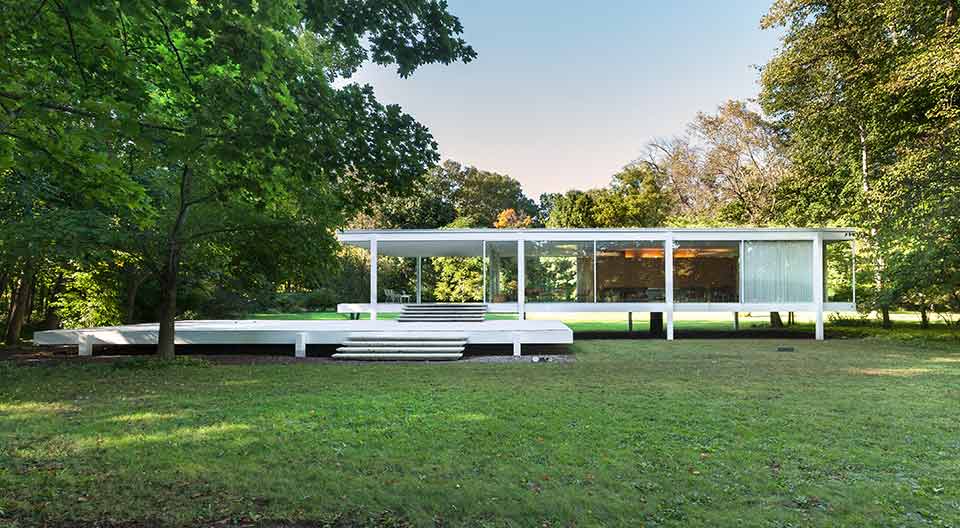
The Farnsworth house is located in 58 miles southwest of downtown Chicago in suburb called Plano, Illinois. The Farnsworth house is one of the best works of Mies van der Rohe. In the farmland outside of Chicago, renowned architect Ludwig Mies van der Rohe designed and constructed a masterpiece along the Fox River between 1945-1951 for Dr. Edith Farnsworth. This place has many controversial historical stories and it was rescued by civic groups. The Farnsworth house was restored and open to the public. Every year thousands of architectural design professionals and house enthusiasts from around the world visit the Farnsworth house.
All tours are scheduled to start from the Visitor Center and include a half mile scenic walk to the House. Whether it is rainy or sunny day, tours operates regularly.
Hours of Operation (April – November) Tuesday through Sunday – 10:00 am – 3:00 pm Closed on Mondays
Photography Policy : Guests are allowed to take photographs of the Farnsworth House’s exterior and grounds for personal memory without using tripod. Photography or video recording is not allowed for commercial use without permission of the Farnsworth House. Visitors are required to purchase permit for interior photography and sign agreement of photography policy.
The Farnsworth House is designated as a National Historic Landmark, the house is widely recognized as an iconic masterpiece of modernist architecture.
Tags Attractions Guided Tours Museums Things to Do Things to do in Chicago
Related Articles
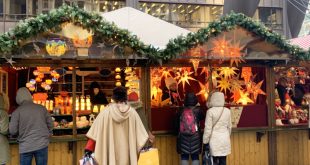
The Christkindlmarket – Christmas Market in Chicago
December 12, 2019
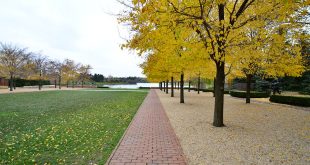
Things to Do in Chicago in Fall 2019
October 1, 2019
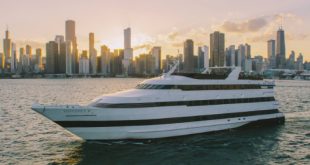
Top Chicago Cruises and Boat Tours
August 10, 2019
This site uses functional cookies and external scripts to improve your experience.
Privacy settings
Privacy Settings
This site uses functional cookies and external scripts to improve your experience. Which cookies and scripts are used and how they impact your visit is specified on the left. You may change your settings at any time. Your choices will not impact your visit.
NOTE: These settings will only apply to the browser and device you are currently using.
Cookies Consent
We use cookies to ensure you receive the best experience on our site. If you continue to use this site, you are agreeing to <a href="https://www.govisitchicago.com/privacy-policy/">our terms and conditions</a>.
A Second Look at Edith Farnsworth and Her Mies van der Rohe–Designed Retreat
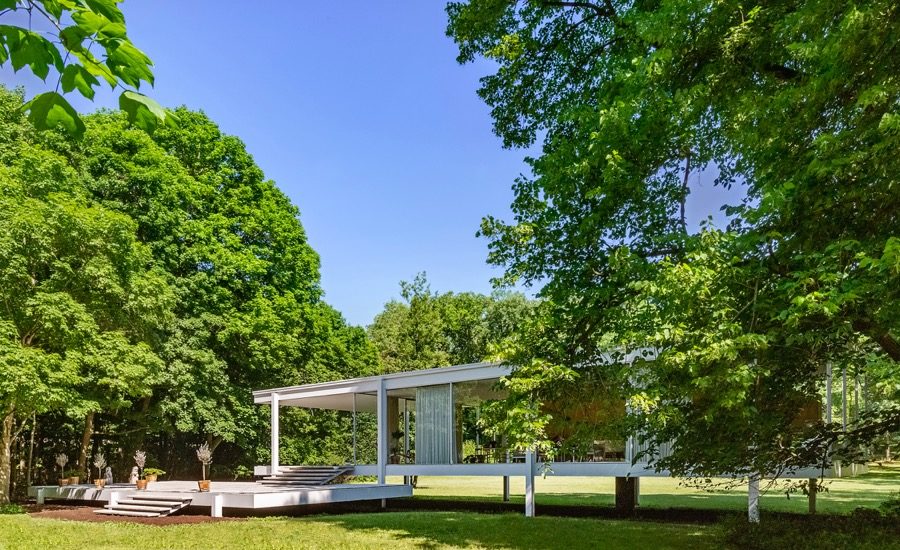
The Farnsworth House, photo © William Zbaren
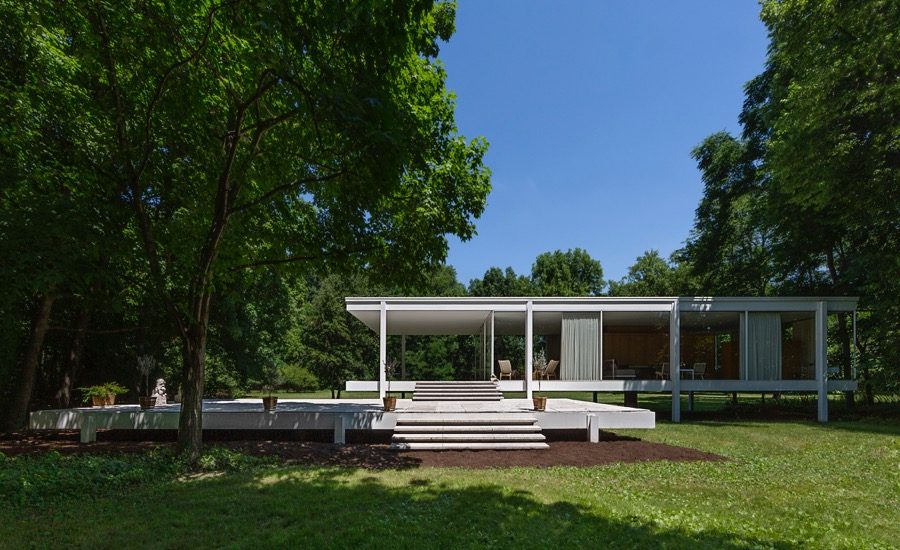
Architects & Firms
During a visit to the latest exhibition at Mies van der Rohe’s Farnsworth House in Plano, Illinois, visitors are more likely to encounter a deer (as this writer did) than a single Mies-designed Brno Chair.
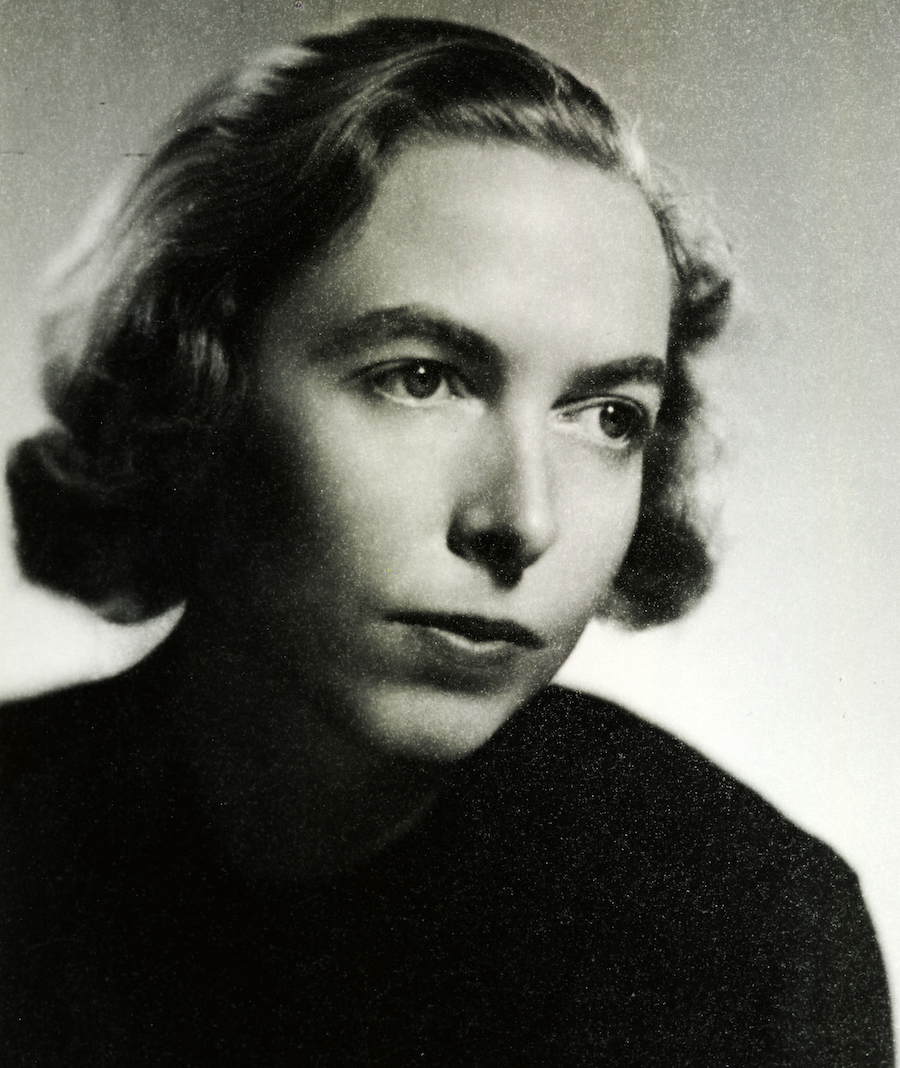
That’s because the year-long, multi-part exhibition called Edith Farnsworth Reconsidered unfolds across nearly 60 acres of forest and riverfront land, focusing on one of the most famous Modern architecture clients in history. At the heart of the show is a restoration of the house as the original owner, Edith Farnsworth, had it furnished circa 1955: with not a single piece of Mies’ work apart from the glass, steel, and travertine house itself.
Mies conceived of the house as a weekend home for Edith, a medical research scientist who developed groundbreaking treatments for kidney disease, and also a polymath classically trained violinist, poet, and translator who staked out a literary career late in life. It was completed in 1951, and was a getaway from her Chicago home till 1969. She sold the house to Lord Peter Palumbo in 1971, the globe-trotting collector of canonical architecture. A year later Palumbo hired Dirk Lohan to restore it to its 1951 appearance, and in 2003, the National Trust for Historic Preservation purchased it, opening it to the public for tours.
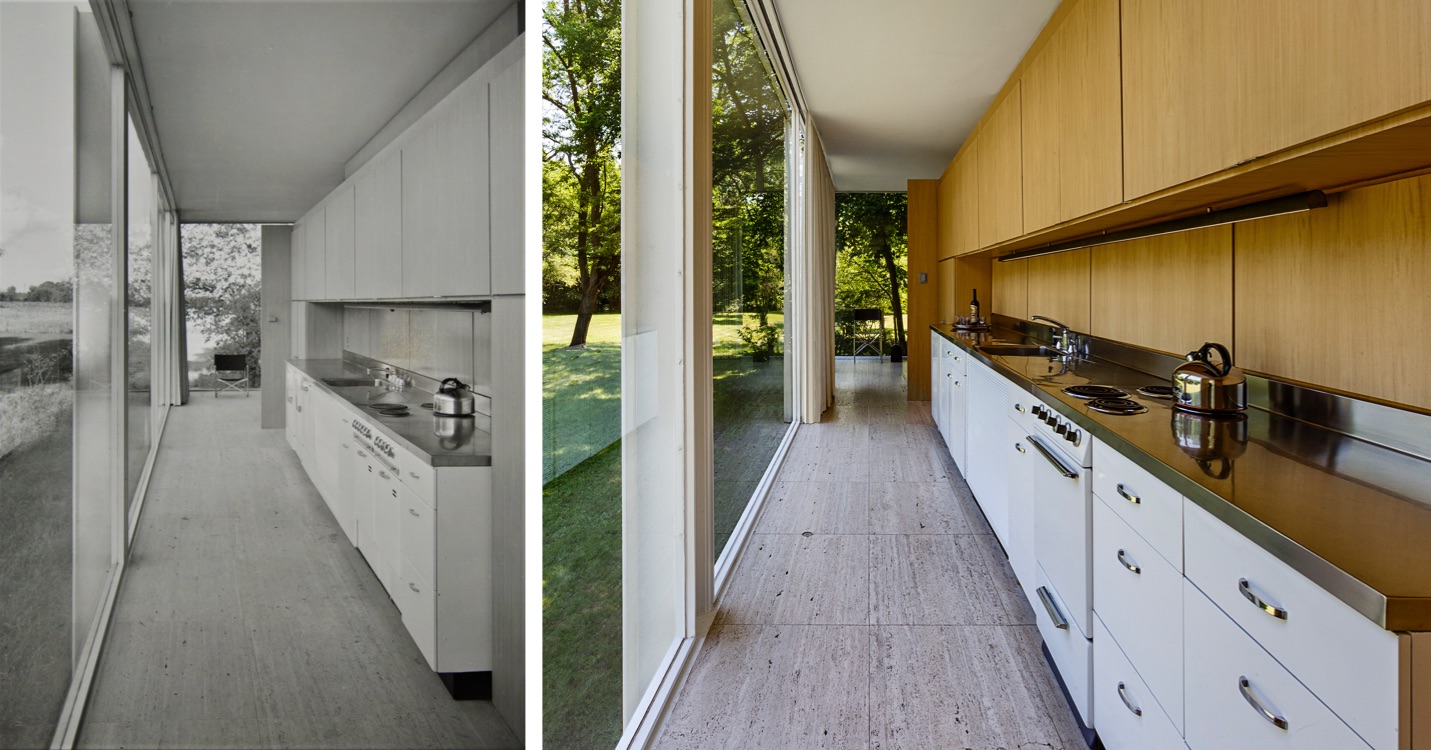
Two small sub-exhibits illuminate this history. An Untold Story: Farnsworth to Palumbo, 1968-1972 , on view through September 6 and curated by T. Paul Young, explores the house’s construction and traces its transition from Edith’s stewardship to Palumbo’s. And in the visitor’s center, biographic and interpretative materials, up through December 2021, shed light on Edith’s exceptional life story.
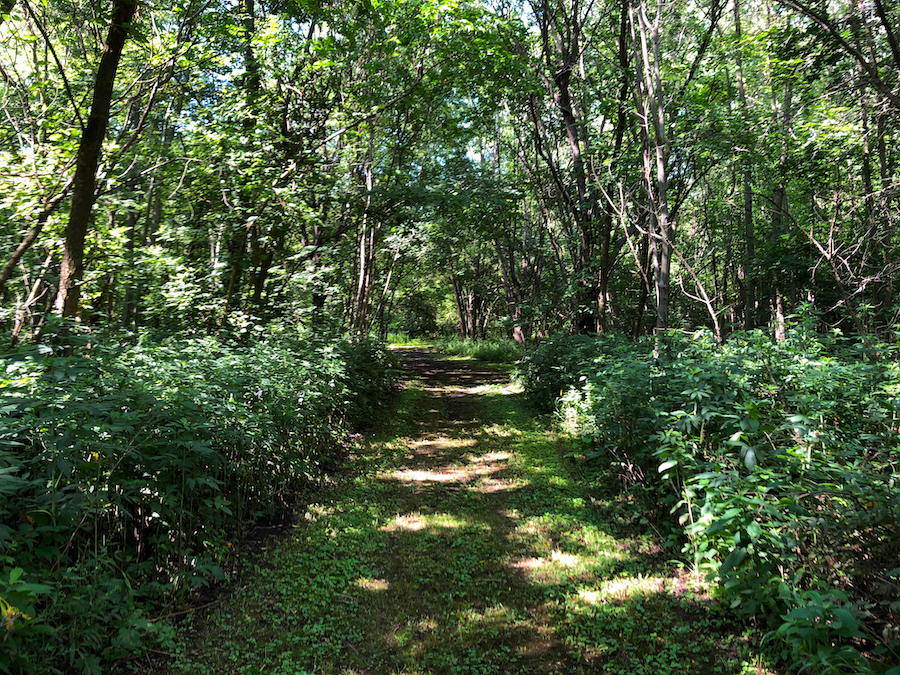
Per coronavirus precautions, the Farnsworth is inviting visitors to linger in the landscape for the first time. Picnic tables and park benches (with complimentary bug spray on hand) are now sprinkled throughout the site’s 2.5 miles of trails, and there’s Wi-Fi for self-guided tours and leisurely browsing. (The house re-opened for guided tours July 1). Alfred Caldwell, Mies’ soulful landscape guru at IIT, supplied Edith with gardens, orchards, and juneberry trees, few of which are left. But along the trails, there’s a strong sense of enclosure under the forest canopy, which is certainly more opaque than Mies’ house. The new arrangement is an opportunity to “reconnect with the land," says Farnsworth House Executive Director Scott Mehaffey. “We have a one-room house on 58.5 acres. Where’s the greater potential?”
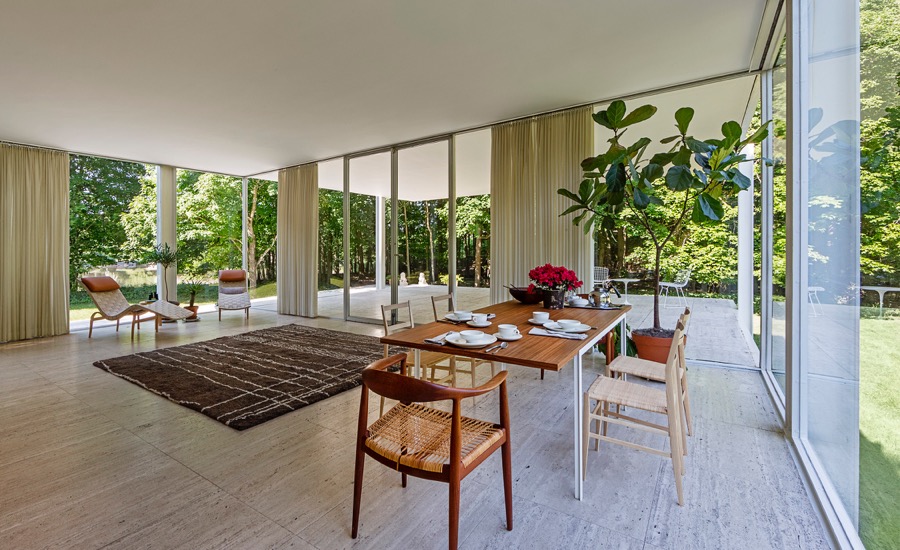
The collection of furniture, dubbed Edith Farnsworth’s Country House , was selected by Mehaffey, with assistance from Robert Kleinschimdt. The installation presents a return to Edith’s more genial and humble take on the residence. Since 1972, Palumbo intended his Farnsworth to be a museum; a Mies showcase with plenty of attention to detail but little historical fidelity to what the house was. With the Country House iteration, Mehaffey wanted to present the house as a lived-in and intimate residence, true to the house’s origins when Edith moved in, if not its place in the architectural imagination. “This was her weekend house. There were stacks of books and magazine. There was dried dog vomit,” says Mehaffey. “We didn’t go that far.” But they did include her medical bag, her Olivetti typewriter alongside copies of her poetry that Farnsworth House staff re-typed, and her violin.
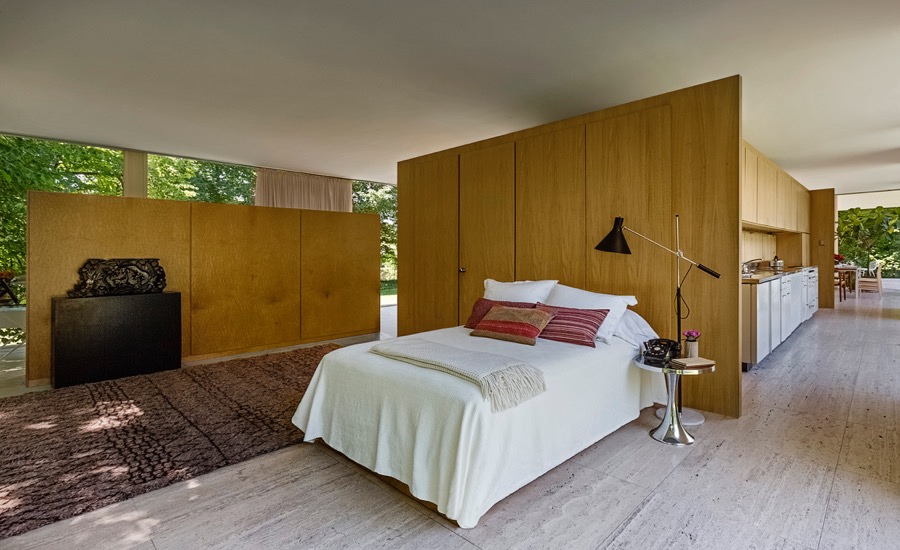
Inside the steel and glass one-room house, there’s the joy of running your toes over opulently wooly Moroccan rugs. It’s a complimentary material opposition that thrives on the crystalline austerity of the house, but was absent the in the house’s previous Mies-furnished, Palumbo-led incarnation. Scandinavian furniture predominates, with woven fabric straps binding together Jens Risom and Bruno Matthson chairs. (Edith rejected Mies’ furniture out of hand as too ponderous and masculine, though Mies did try to sneak in a pink Barcelona Chair.)
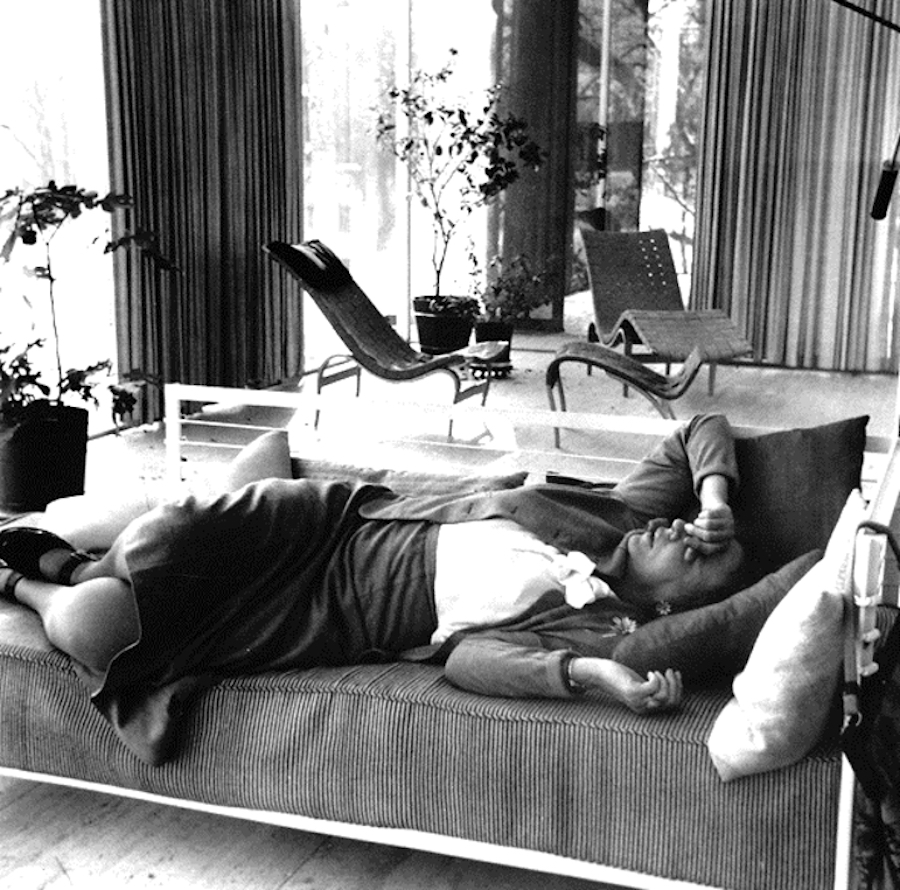
The project had Mehaffey looking through old photos and emailing Modern furniture experts across Europe to identify, source, and if necessary, reverse engineer and reconstruct items. He traced the likely design lineage of Edith’s daybed back to Harry Weese, and made the fabric straps on a pair of bamboo and rattan chairs himself.
It’s altogether a warmer and more humane place now than it was under Palumbo’s care, when spans of travertine threatened to swallow you up. Edith wrote that she often felt like a caged animal on display in the house, and even her predilection for Scandinavian proto-hygge couldn’t quite bridge that gap. By focusing on her vision of how to make the house livable, the curators return agency to a worldly scholar who became more of a passive observer to her place in architectural history. It’s common knowledge that Mies and Edith had a bitter falling out that ended with 4,000 pages of litigation transcripts; a soured affair between the two was suspected as the reason why. But it’s less well known that this supposition is mostly the result of third-hand guesses and innuendo: Mies biographer Franz Schulze introduced it in 1985 with the caveat that he had no proof.
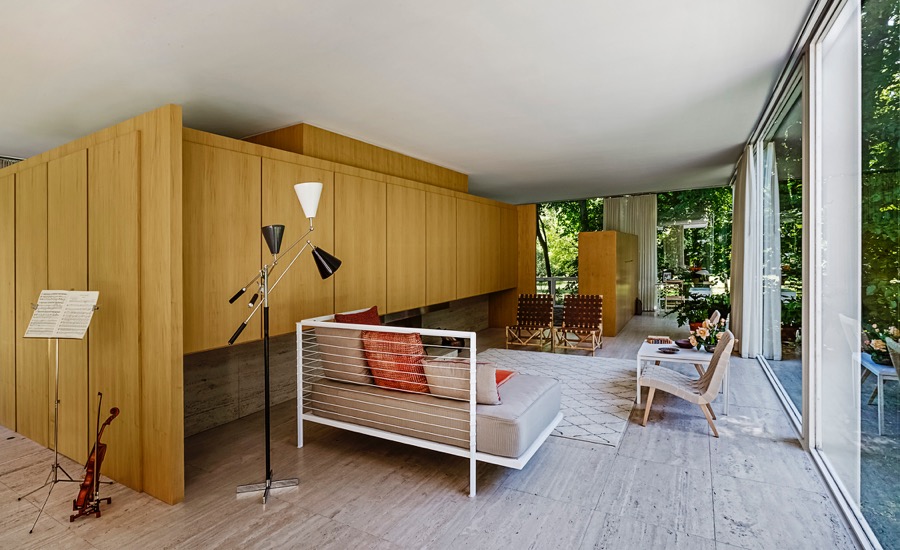
This narrative, according to architecture scholars Nora Wendl and Alice Friedman, enveloped Edith and her house, rendering her another object in Mies’ glass menagerie. Her writing, in both poetry and prose, is as clarifying and articulate as Mies’ architecture, and it never mentioned an affair. Wendl’s scholarship—as well as critical research by Friedman, who was the first to balance the historical record with Edith’s own memoirs—found more evidence for an intense and emotionally intimate friendship than for a torrid entanglement. Early on in her partnership with Mies, Edith enthused that the project was “marvelous because it fulfilled my ideal that persons trained in different fields of the arts and sciences should seek to understand the ideals and the principles common to all fields in advancement, and to lend their loyalty and support.” One can see evidence of her confidence and thirst for knowledge all over her house, even beyond her conventionally excellent design sense. Edith may well have wanted Mies as an intellectual partner instead of a romantic one. “Perhaps it was never a friend and collaborator, so to speak, that [Mies] wanted, but a dupe and a victim,” she wrote later, after the pair's falling out.
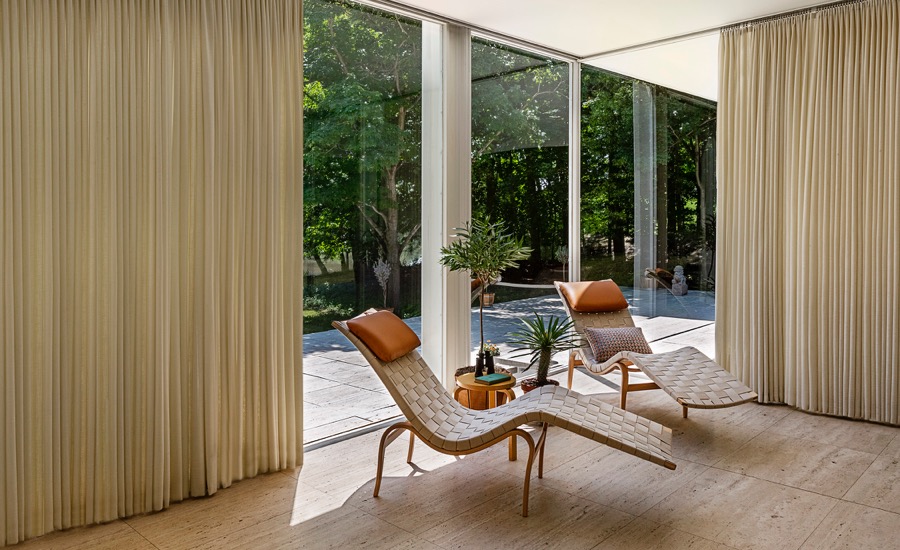
A degree of sadness seems to underpin Edith’s time at the house. In an issue of the MIT architecture journal Thresholds (PDF), Wendl writes that Edith was looking for sanctuary along the Fox River; a reprieve from a world that looked askance at her for stepping outside of the compulsory roles and wife and mother, instead choosing the path of a self-actualized professional. Her initial impulse, Wendl writes, was to “create a significant and meaningful work of architecture that resonated with her own desires for finding a place in a world that had defined her as simply: Edith Farnsworth: An Unmarried Woman.”
It’s bitterly ironic that the sanctuary she founded was not truly for herself, but for legions of Mies devotees in thrall to her insensitive collaborator. Fanning out from the Farnsworth House, these acolytes have propagated the International Style everywhere, making it the dominant historical context in the Western World. Which asks the question: why bother putting all the Mies furniture back? There are already plenty of Barcelona stools in showrooms and galleries. But there are precious few examples of people outside of this narrative, dispossessed of their own story, bending this architecture to work for them and being celebrated for it.
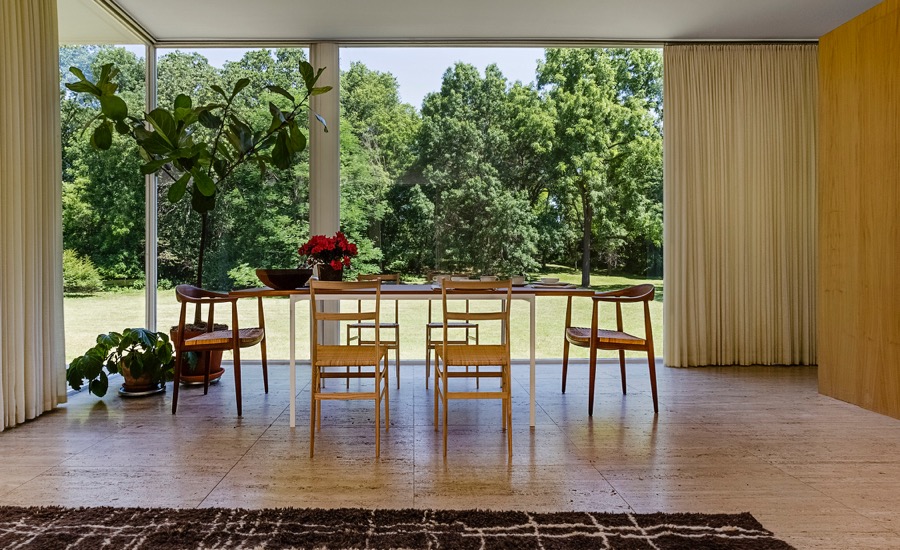
Share This Story

Zach Mortice is a Chicago-based design journalist who focuses on landscape architecture and architecture. You can follow him on Twitter and Instagram @zachmortice.
Post a comment to this article
Report abusive comment, related articles.
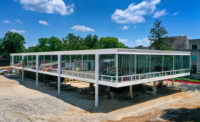
Unbuilt Project by Mies van der Rohe Is Under Construction in Indiana
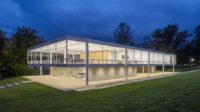
Mies van der Rohe Redux: The Eskenazi School of Art, Architecture + Design by Thomas Phifer and Partners
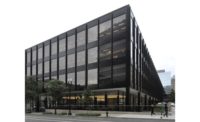
Mecanoo Respectfully Revises Mies van der Rohe’s MLK Library
The latest news and information, #1 source for architectural design, news and products.
Copyright ©2024. All Rights Reserved BNP Media.
Design, CMS, Hosting & Web Development :: ePublishing
Staying current is easy with Crain’s news delivered straight to your inbox.
Free of charge.
Edith farnsworth returns to the center of the story about the house mies designed for her.

Dennis Rodkin is a senior reporter covering residential real estate for Crain’s Chicago Business. He joined Crain’s in 2014 and has been covering real estate in Chicago since 1991.

This spring, with the 20th anniversary of the rescue of a masterpiece of modern architecture, there’s a second rescue to celebrate: the restoration of its first owner, Edith Farnsworth, to a central spot in the narrative of the riverside country house that Ludwig Mies van der Rohe designed for her.
On May 1, 2004, when the tranquil glass and steel pavilion built in 1951 in Plano opened to the public, “the story was about the great man, the architect and what he had created,” said Michelangelo Sabatino, an architectural historian and professor at the IIT College of Architecture.
“Edith was like a sidebar; she was a footnote,” he added.
Two decades later, Farnsworth, a Chicago physician and medical professor who got Mies to design her a second home and then battled him in court over cost overruns, is getting praise as the knowing patron of an architect who, though he revolutionized high-rise architecture, did few houses and none as serenely beautiful as hers.
“It was not meant to be a monument to Mies,” said Scott Mehaffey, executive director of the Edith Farnsworth House, which has been a site of the National Trust for Historic Preservation since 2004.
It was meant to be the elegant country house that one erudite artistic woman asked for “in this wonderful natural landscape she enjoyed,” Mehaffey said. The house, on 62 acres in Plano, 58 miles southwest of Chicago, inspired New York architect Philip Johnson’s design of his famed glass house in Connecticut.

Giving Farnsworth her rightful credit extended to renaming the landmark in 2021 to include her first name, rewriting the script of tours that 10,000 visitors a year hear and complementing the gift shop’s “It’s All About Mies” t-shirts with a shirt that labels her “Fearless.”
It also includes the first-ever publication of the two chapters of Farnsworth’s hand-written memoirs in which she details “from the Sunday morning that she woke up and decided she needed a little bit more of an escape on the weekend,” Sabatino said, “to the moment she decided to sell” the house about two decades after it was finished.
Sabatino transcribed the chapters, which are housed at the Newberry Library, and included them in a book Monacelli Press will publish in June, called “The Edith Farnsworth House: Architecture, Preservation, Culture.”
From the chapters, it becomes clear, Sabatino said, that “Edith was deeply engaged with the natural setting. She knew the trees and she knew the land and she was very deeply engaged with them.” Farnsworth’s profound connection to the wooded site on the edge of the Fox River, he said, kept her focused on ensuring that whatever Mies built there, it should have a similar affinity for its surroundings.
The result was a one-room house, 77 feet long and 29 feet wide, with nearly its entire exterior wrapped in glass, a thin separation between indoors and outdoors. It stands on stilts five feet above the ground, which has mostly kept it above rising water levels in the Fox River, but not always.
The architect was imperious, but Sabatino and Mehaffey said the client was confident enough to go mano a mano with him. Mies ordered the furniture he wanted to put in Farnsworth’s house, Sabatino said, just as the architect had done two decades earlier at Villa Tugendhat, a house he designed in Brno, Czech Republic.
“Mies told her that the Barcelona chairs would be delivered,” Sabatino said, “but Edith said, ‘I don’t want Barcelona chairs.’” She thought the minimalist lines of modern furniture would make the interior of her house feel “like a clinical place,” he said. “She wanted the atmosphere to be a country house, an inviting place.”
After Farnsworth sold the house to architecture collector Sir Peter Palumbo in 1972, he filled it with the type of furniture Mies preferred. In 2020, when the house — by then a longtime museum — was temporarily furnished with the Moroccan rugs and other, warmer items that Farnsworth preferred, Chicago Tribune architecture critic Blair Kamin wrote that “the interior seems warmer, more in tune with nature, and above all, more livable.”
Mehaffey said there’s a rotating schedule for the furnishings. When filled with modernist furniture, the house “honors the Palumbo period,” he said, “which was a significant period for the house.” Palumbo’s ownership stretched from 1972 to 2023, a decade longer than Farnsworth owned the house. Farnsworth’s decor will be back in 2026, Mehaffey said.
May 1 is the 20th anniversary of the glass pavilion opening as a public asset, but that day was the culmination of a three-year effort. In 2001, when Palumbo first announced his plan to sell, then-Gov. George Ryan persuaded Illinois legislators to budget about $7.5 million to buy it. But in 2003, then-Illinois Attorney General Lisa Madigan killed the plan over lack of funding, and preservationists feared the house might be sold to someone who would haul it out of Illinois.
Sotheby’s, the auction company that was handling the sale, “even put out a video showing how you could take it apart and re-assemble it,” Mehaffey said.
In the December 2003 auction, a coalition of preservationist donors and nonprofits, including the National Trust as well as Illinois Landmarks, made the winning bid of $7.5 million. “The sale lays to rest months of fear that (the house) would be sold to a developer and moved from its site,” The New York Times reported. “Preservationists said moving the house, long considered a landmark of domestic Modernist architecture, would destroy the context for which Mies had designed it.”
Farnsworth was mentioned once in the Times story, in the 10th of 18 paragraphs.

More in Residential Real Estate

Rocky Wirtz's daughter Hillary is selling her Wilmette home
A fourth-generation member of the Wirtz beverage, real estate and Blackhawks dynasty, she's asking a little under $1.2 million for the five-bedroom house.

House on Wicker Park's mansion row sold in a few days, for full price
Some of its more expensive neighbors in the core historical blocks of the landmark district have spent months on the market.

Lawsuit aims to stop Illinois counties from selling homes over unpaid taxes
Sparked by the U.S. Supreme Court's ruling last year that governments cannot profit by taking someone's real estate, the case filed in Southern Illinois last week follows a November filing in Northern Illinois.
Most Popular
Get our newsletters.
Staying current is easy with Crain's news delivered straight to your inbox, free of charge.
Subscribe today
With a Crain’s Chicago Subscription you get exclusive access, insights and experiences to help you succeed in business.
- Destinations & Attractions
- Itineraries
- Supplier Profiles
- Exclusive emails
- Group Tour Magazine
- Other Publications
- Youth Travel Planner Back Issues
- Newsletters

Quintana Roo Destination of Choice for Travelers
Upcoming solar eclipse to draw travelers to states in path of totality, indiana convention center and hilton formalize agreement, new horizons, american bus association annual convention draws thousands.
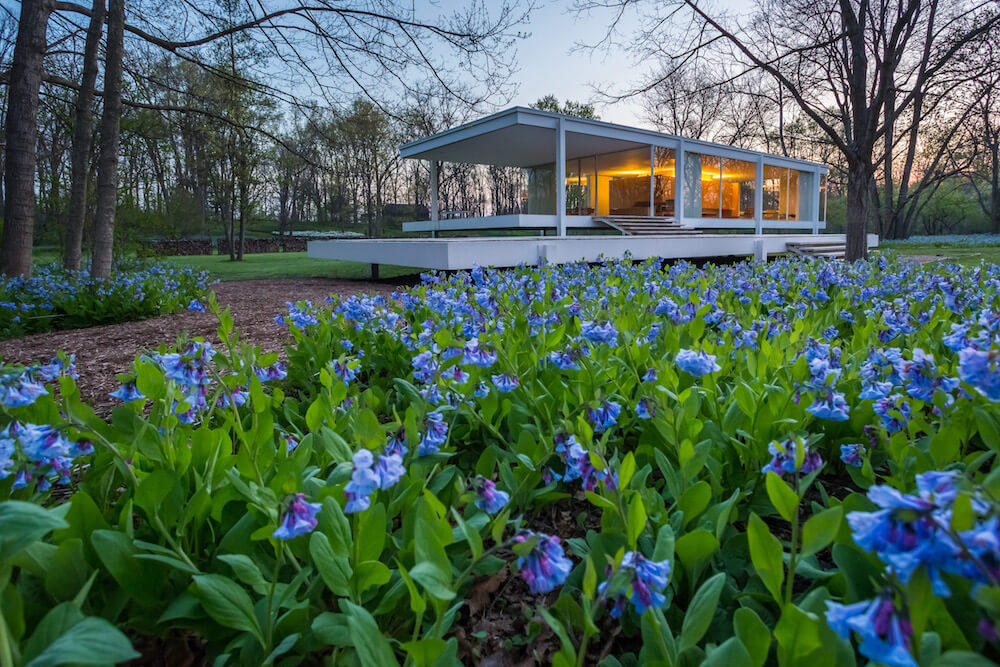
The Farnsworth House mixes architecture and nature
Step into a 1950s time capsule and experience an architectural masterpiece at The Farnsworth House in Plano, Illinois.
Built in 1951 as a weekend retreat for Dr. Edith Farnsworth, a Chicago research physician, The Farnsworth House is one of 20th-century modern architect Ludwig Mies van der Rohe’s most famous works.
The home’s natural setting is the cornerstone of the tour experience. Tucked away in a floodplain forest along the bank of the Fox River, its surplus of glass walls gives the home an almost transparent appearance among thick tree trunks and lush greenery surrounding the property.
“The best part of the visit is being inside the house and seeing nature all around you — being ‘a part of and apart from’ as the saying goes,” said Scott Mehaffey, executive director of The Farnsworth House. “The pastoral rural location remains an important part of the experience and a large portion of the walking tour. In the spring, the mix of daffodils and bluebells is stunning — and fall color in this woodland setting is equally as beautiful.”

After arriving at the Visitor Center, groups will watch a short orientation film then walk, accompanied by a Farnsworth guide, about a half mile around the grounds to the house. After the tour, visitors can shop, enjoy the outdoor café seating or see an exhibition in Farnsworth Gallery located next to the Visitor Center.
The Farnsworth House’s architecture represents Mies van der Rohe’s minimalist expression of structure and space — a piece of architectural artwork heavily inspired by the designs of Frank Lloyd Wright.
Inside, guests can roam the 1,500-square-foot home, yet feel at one with nature sitting just on the other side of the glass walls. On the outside, visitors marvel at the home’s continuous ceiling planes that extend beyond the interiors to external overhangs and porch coverings.
Groups of 15 or more must book their guided, 90-minute tour in advance to secure their spot. Visitors can experience The Farnsworth House year-round.
For more information on The Farnsworth House call 630-552-0052 or visit farnsworthhouse.org .
Article by Erica Zazo
RELATED ARTICLES MORE FROM AUTHOR

Coastal Virginia

A Ride Through History

Reviving the Past
Recent posts, itinerary: laurel highlands, pennsylvania, itinerary: frankenmuth, michigan, little rock welcomes hundreds for domestic showcase , trending now.

Idaho Falls is a destination without limitation

Rhode Island itinerary: Newport

New York itinerary: Lake George Area in the Adirondacks

Sail back in time at the Titanic Museum Attraction

Feed your brain at COSI

Georgia itinerary: Macon

GroupTourMagazine.com is the online home of Group Tour Magazine, the premiere resource for the professional group travel planner. Contact us: [email protected]
© Greenspring Media | All rights reserved
GREENSPRING MEDIA SUBSCRIBE CONTACT US ADVERTISER INFO
What’s That Building? The Edith Farnsworth House
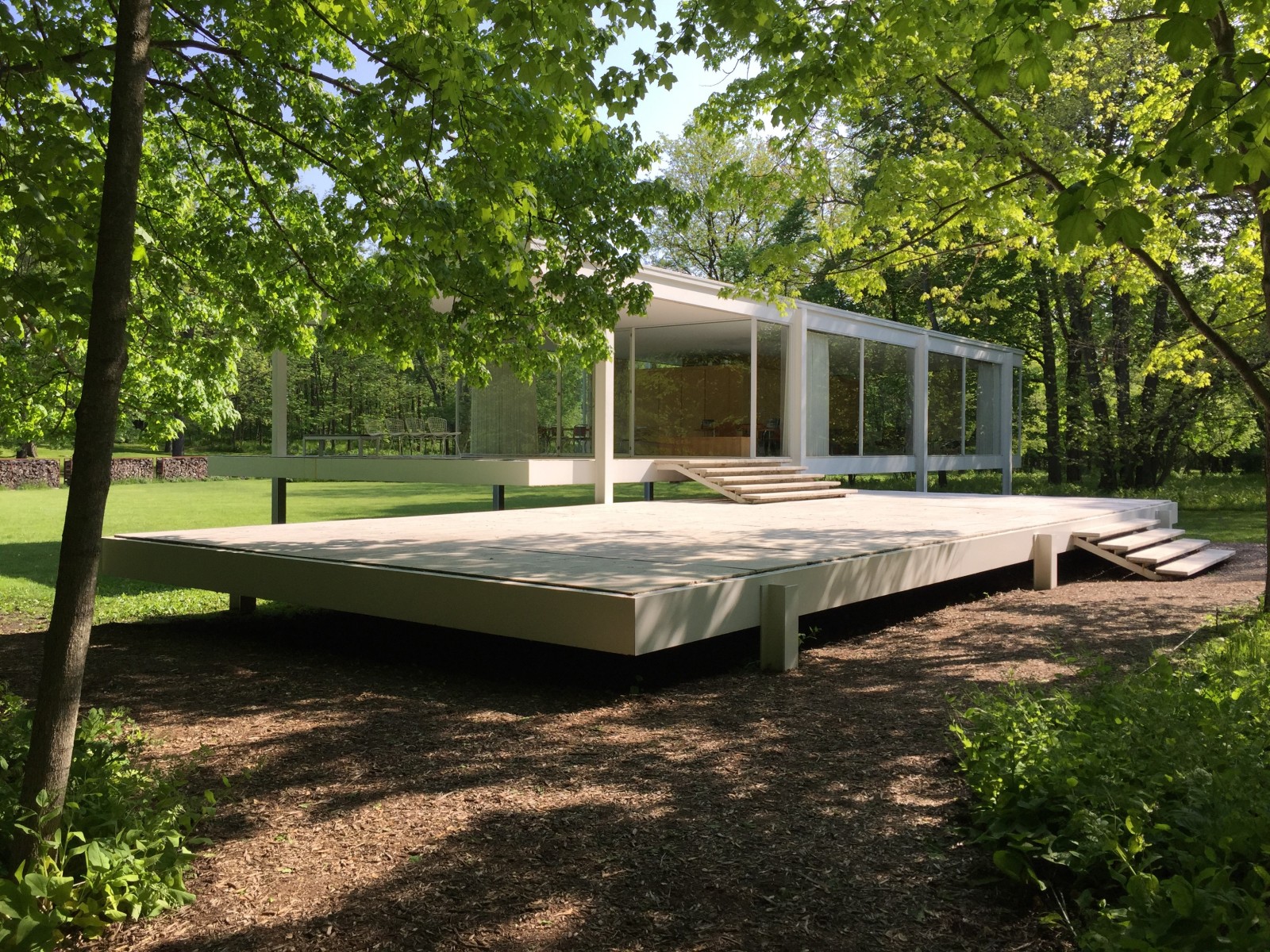
- Reset with Sasha-Ann Simons
- Culture & The Arts
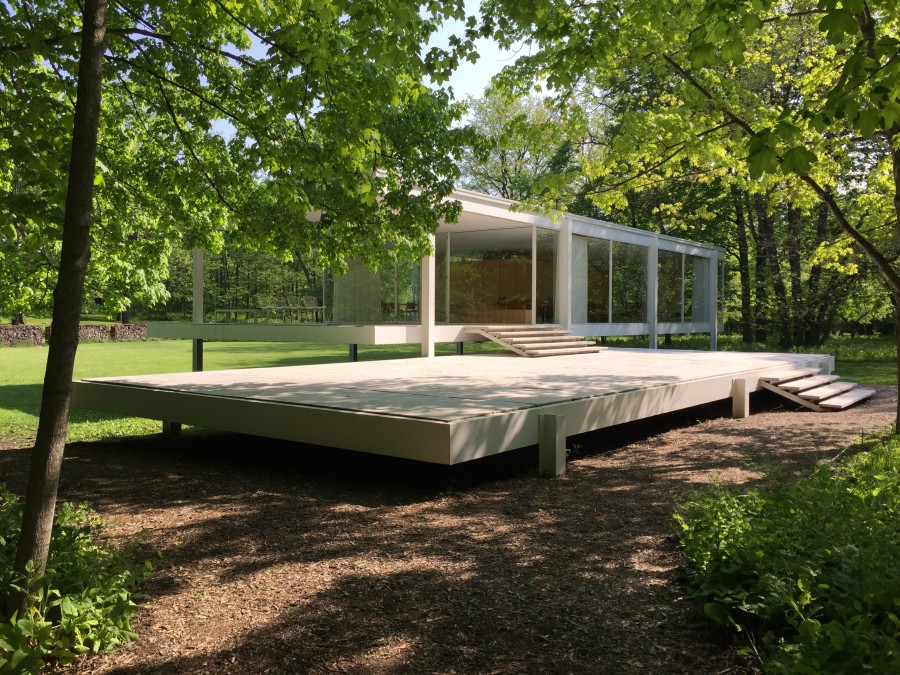
A pair of glass and black steel apartment buildings on Lake Shore Drive in Streeterville are so strongly identified with their architect they are often simply called “the Mies buildings,” but Ludwig Mies van der Rohe designed another famous building that year sixty miles southwest.
In Plano, a long, serene pavilion of glass and white painted steel located at 14520 River Road sits on stilts above the ground so it appears to be floating near the banks of the Fox River.
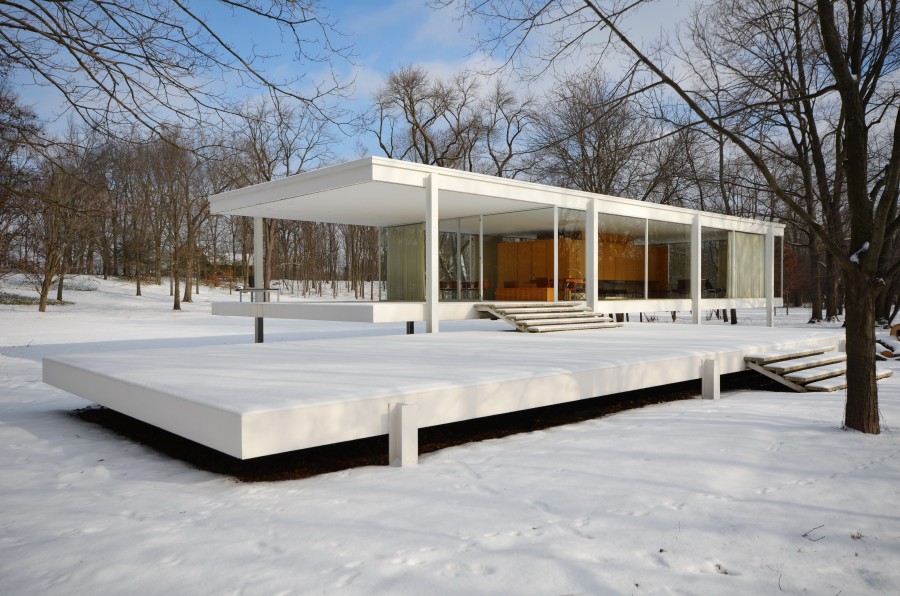
The house, designed in 1951 to be the weekend getaway of a Chicago physician, has recently undergone a subtle change. Long known as Farnsworth House, it officially became the Edith Farnsworth House on Nov. 17, 2021. That date would have been the 118th birthday of its namesake, the omnivorously intellectual woman who commissioned Mies to build it and later battled him in court.
The name change emphasizes that “this was one woman’s place of her own,” said Scott Mehaffey, executive director of the Edith Farnsworth House , a site of the National Trust for Historic Preservation.
Mehaffey, who’s been on the job since 2018, has been nudging along a shift in the narrative about the house. The change is being done with no disrespect to Mies, who designed a sublime, ethereal place to watch wildlife and the river drift past. Instead, something that used to be a secondary part of the story, Edith Farnsworth’s fundamental role in getting this special place built, is being lifted up.
For anyone who hasn’t been to the house, a trip to Plano to see it is worth the effort. The tour starts in a separate building, with a film and exhibits that whet your appetite. Then you walk about half a mile through the woods along the banks of the Fox River until you come to a broad, grassy clearing where the house floats like a barge over the ground. The home looks like one long bar of glass between the steel roof and floor, with travertine marble steps cascading down.
When you go inside the four walls of glass, the natural setting suffuses the interior. The home really is a transcendent place.
That’s what Edith Farnsworth wanted for the riverside land she bought in the 1940s from Col. Robert McCormick, the owner of the Chicago Tribune , who had operated a demonstration farm there.
Born in 1903 to a wealthy Chicago family and brought up on Astor Street, she got her medical degree from Northwestern University in 1938, at a time when very few women were doctors. In 1942, the Tribune wrote of her and one other woman doctor , saying it was “a curious thing that purlieus of upper Astor Street [would] burst the bonds of social life” to go into medicine, a man’s profession.
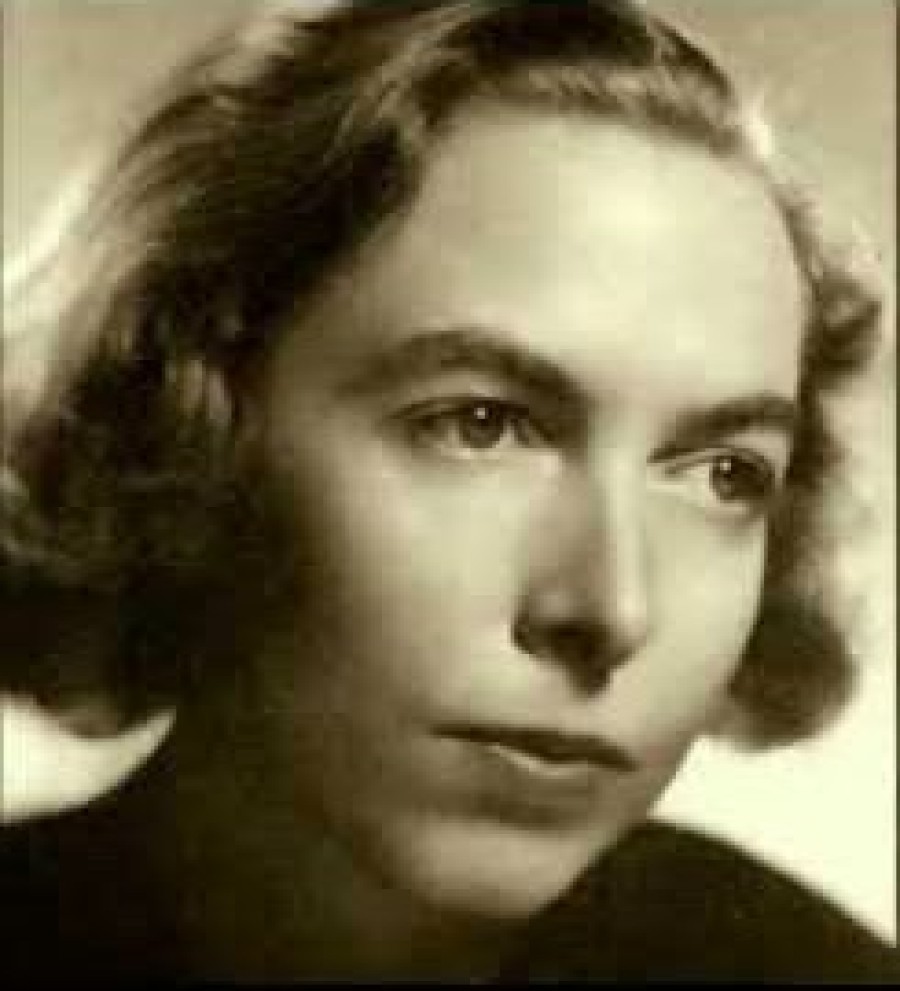
A kidney specialist, Farnsworth eventually had her own research lab at Passavant Hospital, which later became part of Northwestern, and also saw patients.
Single by choice, according to Mehaffey, Farnsworth “was a proto-feminist.”
“She was so far ahead of her time, self-actualized and self-fulfilled, traveling and writing poetry and running a research lab,” he said.
That was in addition to a volunteer gig.
“She writes in her diaries about her volunteer midwife assignment, birthing babies on filthy kitchen floors in the slums of Chicago,” Mehaffey said.
Clearly, the woman was a force.
But this is not how Farnsworth used to be described. After she sued Mies in the 1950s over cost overruns and was quoted in House Beautiful magazine saying that Mies’s attitude about everything from furniture to the kitchen trash can was very controlling, she came to be thought of as a frustrated spinster who either loved Mies and lost him or loved him and didn’t get him.
Mies, according to Mehaffey, “did what he could to keep that story going about her.” Because he was one of the great architects of the 20th century — and a man — his version of the story prevailed.
The narrative got cemented in 1986, nine years after she died. That year, Franz Schulze , a Lake Forest College art professor and freelance Chicago Sun-Times art critic, published a book in which he wrote that “most witnesses to the Mies-Farnsworth friendship agree that it was a romance of some sort.” He quoted Farnsworth’s estranged sister, Marion, saying she was “mesmerized” by Mies. Schulze also included a photo of Farnsworth and noted that she was “no beauty. Six feet tallk, ungainly of carriage and rather equine in features.”
She was, Schulze wrote, “sensitive about her physical person and may very well have compensated for it by cultivating her considerable mental powers.”
The misogyny of it is startling to read now.
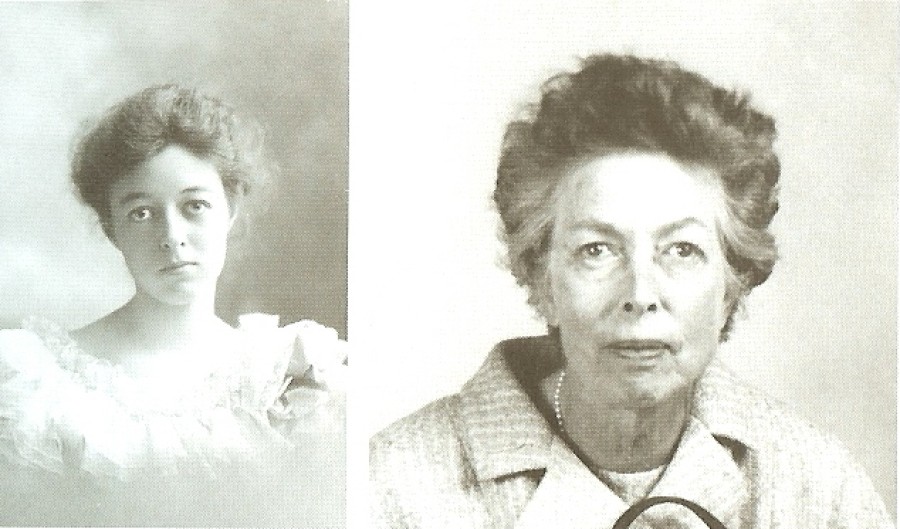
Mehaffey said elevating Edith Farnsworth in the story of her house is part of “telling the whole story of a woman who made history, who built this house.”
The later story of the house is also being expanded. From 1971 to 2003, the British real estate tycoon Lord Peter Palumbo owned the house. Exhibits and materials about those years now also talk about Hayat Palumbo , who married Lord Peter in 1986 and often came to Plano, according to Mehaffey.
Dennis Rodkin is the residential real estate reporter for Crain’s Chicago Business and Reset’s “What’s That Building?” contributor. Follow him @Dennis_Rodkin .
The Farnsworth House is renamed to honor Edith Farnsworth
- Mass Timber
- Trading Notes
- Outdoor Spaces
- Reuse + Renewal
- Architecture
- Development
- Preservation
- Sustainability
- Transportation
- International
What's In A Name?

For the 70th anniversary of the (formerly known as) Farnsworth House , Ludwig Mies van der Rohe ’s first realized home in the United States and a National Historic Landmark, is being rebranded to better recognize the contributions of its commissioner: Edith Farnsworth.
This morning, the National Trust for Historic Preservation and managing organization of the house jointly rededicated the Edith Farnsworth House to shine a spotlight on her role in the design. The Plano, Illinois, home, a single glass-wrapped room that appears to float between two slabs, is a touchstone of modern architecture but is often wholly attributed to the mind of Mies. Rather than being an object of desire for Mies caught in his singular gravitational pull as “the genius artist,” Edith played a larger role in the house’s conception than architectural canon gives her credit for. Far from a passive client, Farnsworth was an active patron of the arts and advocate for innovation.
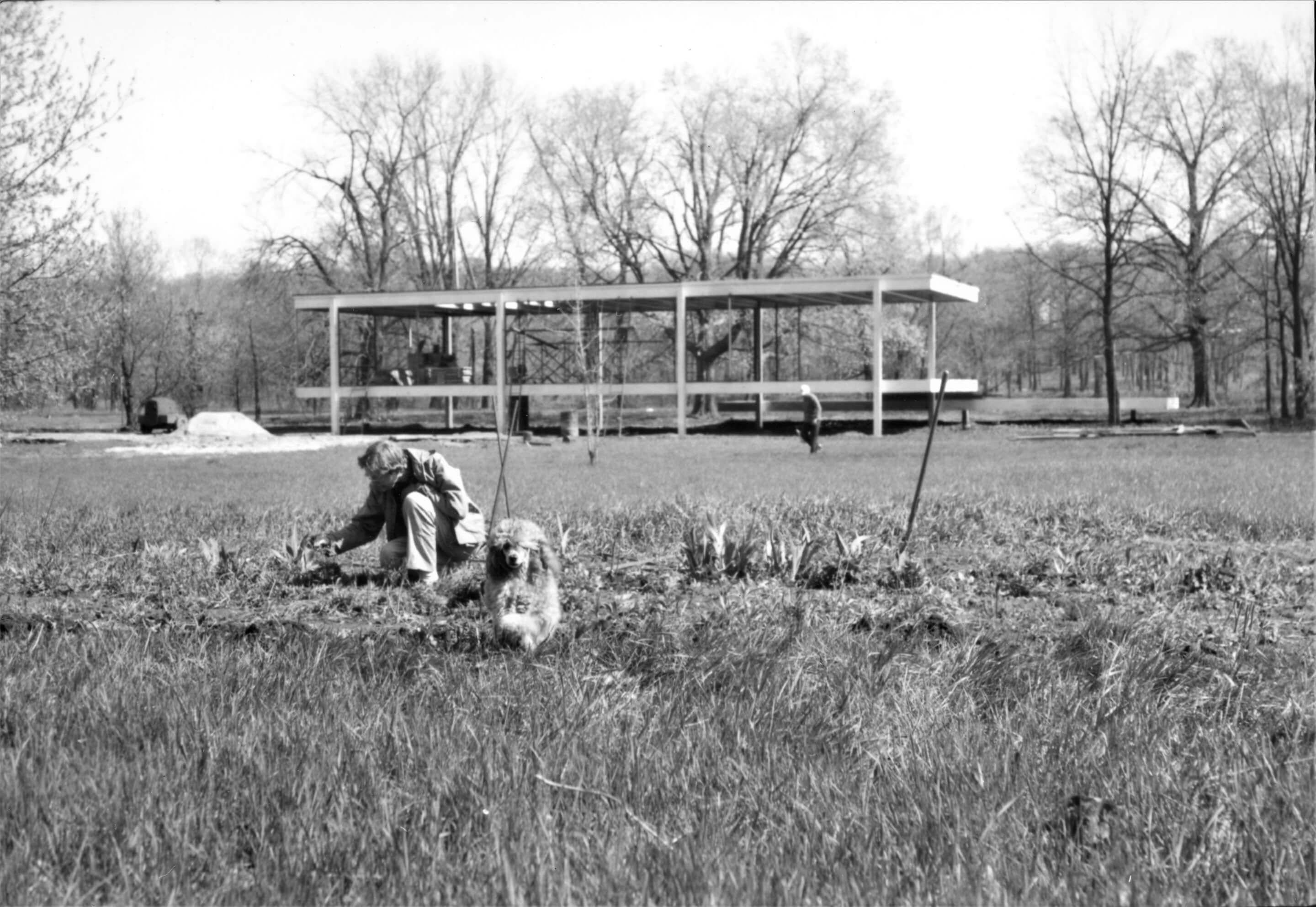
“We hope this seemingly simple act of inserting her first name has the larger effect of inserting her into the ongoing history of modern architecture,” said Scott Mehaffey, executive director of the Edith Farnsworth House in the announcement today. “Without Edith Farnsworth, Mies van der Rohe’s American career might have remained stalled and his stature usurped by his contemporaries. Edith was fully aware that she was both a client and a patron, and she played an active role in the design of her house, which has become a celebrated milestone in the evolution of modernism.”
The recentering is part of the National Trust’s Where Women Made History campaign , an ongoing attempt to raise awareness of the efforts of women in realizing sites of historic mettle in the public’s attention. (America’s “commemorative landscape” is sorely lacking public art or other testaments to the historical achievements of women, according to a new Monument Lab survey of more than 50,000 memorials.)
“From the moment of its completion, Edith Farnsworth’s home was publicly and primarily associated with its architect, Mies van der Rohe,” said Christina Morris, leader of Where Women Made History, in the announcement. “Rededicating the site enshrines her role in the creative process and ensures that the original patron and owner of this modern icon—an independent woman, medical professional, and artistic spirit—will be squarely at the center of the story, where she belongs.”
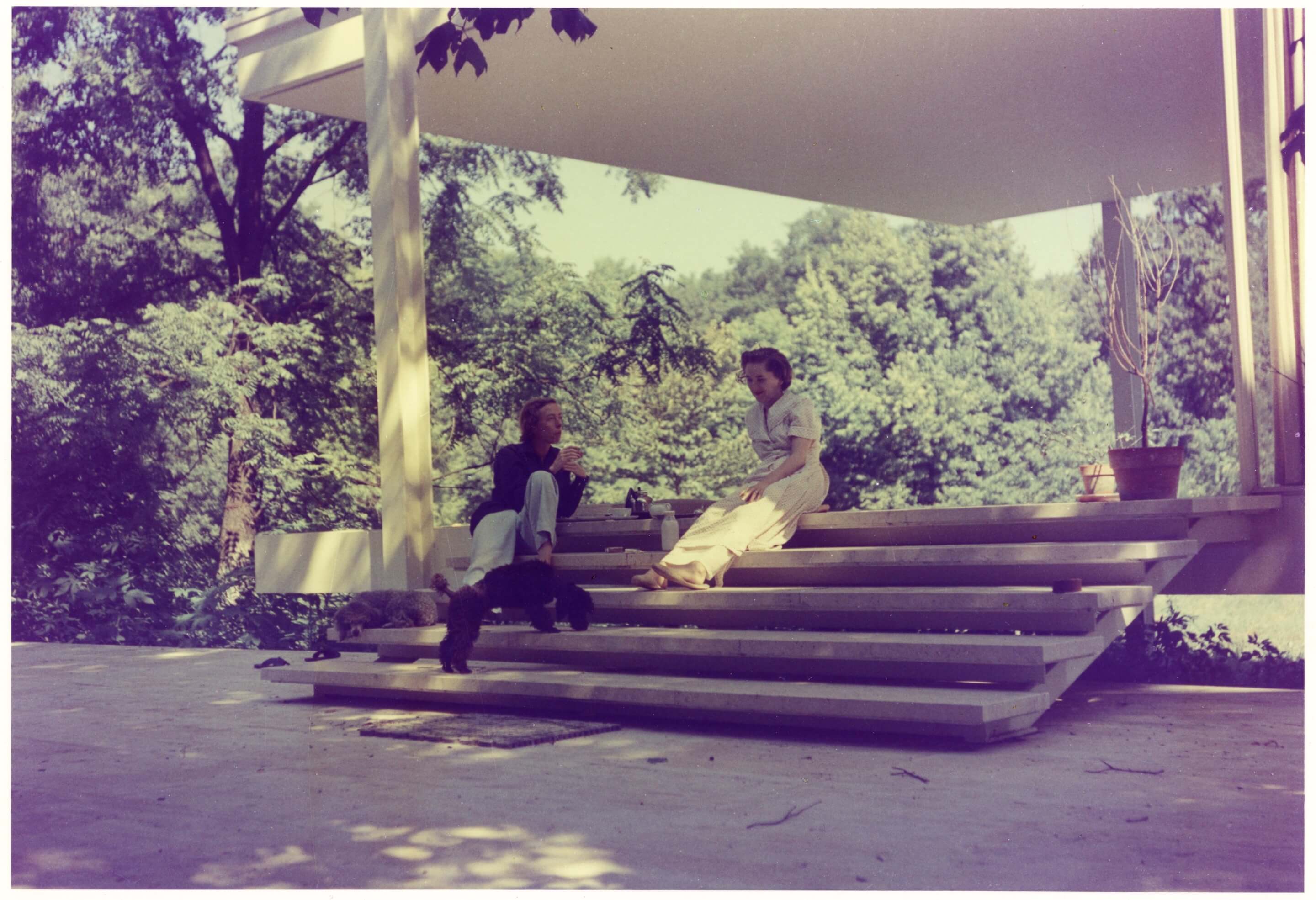
The renaming comes on the heels of last summer’s sprawling Edith Farnsworth Reconsidered , an exhibition that humanized its subject by translating Edith’s inner life, upbringing, and legal tussles with Mies through furniture, recreating how she would have actually lived in the building. That show is still running, alongside a complementary second initiative; through December 19, 2021, visitors can take a guided tour through Edith Farnsworth’s Country House , a recreation of how the home would have appeared in 1955.
An official rededication ceremony will be livestreamed through the Edith Farnsworth House’s social media channels on November 17, Farnsworth’s birthday, at 2:00 p.m. CST.
Meanwhile, work on better exposing the history of the Edith Farnsworth House is running concurrently with attempts to restore and weatherproof the physical structure. Sited on a 60-acre parcel of woods in the Fox River floodplain, the home was besieged by floodwaters after historic rain hit Illinois last May . The $700,000 Lower Terrace Restoration Project to restore and replace the damaged travertine lining the building’s lower deck was successfully funded in July of this year and work will also wrap up on November 17, but that’s just one small part of a broader National Trust plan that includes improving the waterproofing and drainage at the site.

Sixty-five years after the completion of the Seagram Building, Phyllis Lambert talks about Mies van der Rohe and the commission
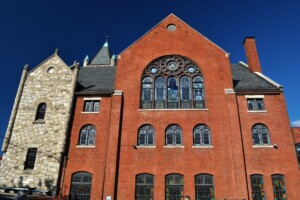
African American Cultural Heritage Action Fund announces 31 historic Black churches to receive funding
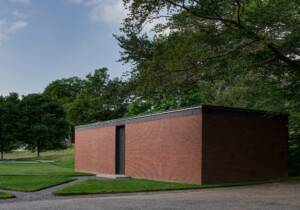
Philip Johnson’s 1949 Brick House in New Canaan is being restored by Mark Stoner and the National Trust for Historic Preservation
The Charnel-House
From bauhaus to beinhaus.

Moscow metro

Buried treasure: The splendor of the Moscow Metro system
Owen hatherley the calvert journal january 29, 2013.
. Reposted from The Calvert Journal , a daily briefing on the culture and creativity of modern Russia.
. Post-Communist underground stations in Moscow, like the recently completed Pyatnitskoye shosse, are still, very visibly, Moscow Metro stations. Regardless of the need or otherwise for nuclear shelters, they’re still buried deep in the ground; ubiquitous still is the expensive, laborious, but highly legible and architecturally breathtaking practice of providing high-ceilinged vaults with the trains leaving from either side. There have been attempts at “normal” metro lines, like the sober stations built under Khrushchev, or the “Light Metro” finished in 2003, but they didn’t catch on. Largely, the model developed in the mid-1930s continues, and not just in Moscow — extensions in Kiev or St Petersburg, or altogether new systems in Kazan or Almaty, carry on this peculiar tradition. Metro stations are still being treated as palaces of the people, over two decades after the “people’s” states collapsed. This could be a question of maintaining quality control, but then quality is not conspicuous in the Russian built environment. So why does this endure?

. The original, 1930s Moscow Metro was the place where even the most skeptical fellow travellers threw away their doubts and surrendered. Bertolt Brecht wrote an awe-filled poem on the subject, “The Moscow Workers Take Possession of the Great Metro on April 27, 1935,” dropping his habitual irony and dialectic to describe the Metro workers perusing the system they’d built on the day of its opening. At the end, the poet gasps, his guard down, “This is the grand picture that once upon a time/ rocked the writers who foresaw it” — that is, that here, at least, a dream of “Communism” had been palpably built. It was not an uncommon reaction, then or now, nostalgia notwithstanding. The first stations, those Brecht was talking about, were not particularly over-ornamented, especially by the standards of what came later, but their extreme opulence and spaciousness was still overwhelming. Stations like Sokolniki or Kropotkinskaya didn’t bludgeon with classical reminisces and mosaics. Yet three things about the underground designs created by architects Alexei Dushkin, Ivan Fomin, Dmitry Chechulin et al were unprecedented in any previous public transport network, whether Charles Holden’s London, Alfred Grenander’s Berlin or Hector Guimard’s Paris. First, the huge size of the halls, their high ceilings and widely-spaced columns; second, the quality of the materials, with various coloured marbles shipped in from all over the USSR; and third, the lighting, emerging from individually-designed, surreal chandeliers, often murkily atmospheric, designed to create mood rather than light.
[youtube=https://www.youtube.com/watch?v=jDC9Fd7UT9w] Continue reading →
With lightning telegrams:
Moscow Metro Tour
- Page active

Description
Moscow metro private tours.
- 2-hour tour $87: 10 Must-See Moscow Metro stations with hotel pick-up and drop-off
- 3-hour tour $137: 20 Must-See Moscow Metro stations with Russian lunch in beautifully-decorated Metro Diner + hotel pick-up and drop off.
- Metro pass is included in the price of both tours.
Highlight of Metro Tour
- Visit 10 must-see stations of Moscow metro on 2-hr tour and 20 Metro stations on 3-hr tour, including grand Komsomolskaya station with its distinctive Baroque décor, aristocratic Mayakovskaya station with Soviet mosaics, legendary Revolution Square station with 72 bronze sculptures and more!
- Explore Museum of Moscow Metro and learn a ton of technical and historical facts;
- Listen to the secrets about the Metro-2, a secret line supposedly used by the government and KGB;
- Experience a selection of most striking features of Moscow Metro hidden from most tourists and even locals;
- Discover the underground treasure of Russian Soviet past – from mosaics to bronzes, paintings, marble arches, stained glass and even paleontological elements;
- Learn fun stories and myths about Coffee Ring, Zodiac signs of Moscow Metro and more;
- Admire Soviet-era architecture of pre- and post- World War II perious;
- Enjoy panoramic views of Sparrow Hills from Luzhniki Metro Bridge – MetroMost, the only station of Moscow Metro located over water and the highest station above ground level;
- If lucky, catch a unique «Aquarelle Train» – a wheeled picture gallery, brightly painted with images of peony, chrysanthemums, daisies, sunflowers and each car unit is unique;
- Become an expert at navigating the legendary Moscow Metro system;
- Have fun time with a very friendly local;
- + Atmospheric Metro lunch in Moscow’s the only Metro Diner (included in a 3-hr tour)
Hotel Pick-up
Metro stations:.
Komsomolskaya
Novoslobodskaya
Prospekt Mira
Belorusskaya
Mayakovskaya
Novokuznetskaya
Revolution Square
Sparrow Hills
+ for 3-hour tour
Victory Park
Slavic Boulevard
Vystavochnaya
Dostoevskaya
Elektrozavodskaya
Partizanskaya
Museum of Moscow Metro
- Drop-off at your hotel, Novodevichy Convent, Sparrow Hills or any place you wish
- + Russian lunch in Metro Diner with artistic metro-style interior for 3-hour tour
Fun facts from our Moscow Metro Tours:
From the very first days of its existence, the Moscow Metro was the object of civil defense, used as a bomb shelter, and designed as a defense for a possible attack on the Soviet Union.
At a depth of 50 to 120 meters lies the second, the coded system of Metro-2 of Moscow subway, which is equipped with everything you need, from food storage to the nuclear button.
According to some sources, the total length of Metro-2 reaches over 150 kilometers.
The Museum was opened on Sportivnaya metro station on November 6, 1967. It features the most interesting models of trains and stations.
Coffee Ring
The first scheme of Moscow Metro looked like a bunch of separate lines. Listen to a myth about Joseph Stalin and the main brown line of Moscow Metro.
Zodiac Metro
According to some astrologers, each of the 12 stops of the Moscow Ring Line corresponds to a particular sign of the zodiac and divides the city into astrological sector.
Astrologers believe that being in a particular zadiac sector of Moscow for a long time, you attract certain energy and events into your life.
Paleontological finds
Red marble walls of some of the Metro stations hide in themselves petrified inhabitants of ancient seas. Try and find some!
- Every day each car in Moscow metro passes more than 600 km, which is the distance from Moscow to St. Petersburg.
- Moscow subway system is the 5th in the intensity of use (after the subways of Beijing, Tokyo, Seoul and Shanghai).
- The interval in the movement of trains in rush hour is 90 seconds .
What you get:
- + A friend in Moscow.
- + Private & customized Moscow tour.
- + An exciting pastime, not just boring history lessons.
- + An authentic experience of local life.
- + Flexibility during the walking tour: changes can be made at any time to suit individual preferences.
- + Amazing deals for breakfast, lunch, and dinner in the very best cafes & restaurants. Discounts on weekdays (Mon-Fri).
- + A photo session amongst spectacular Moscow scenery that can be treasured for a lifetime.
- + Good value for souvenirs, taxis, and hotels.
- + Expert advice on what to do, where to go, and how to make the most of your time in Moscow.
Write your review
- Preplanned tours
- Daytrips out of Moscow
- Themed tours
- Customized tours
- St. Petersburg
Moscow Metro
The Moscow Metro Tour is included in most guided tours’ itineraries. Opened in 1935, under Stalin’s regime, the metro was not only meant to solve transport problems, but also was hailed as “a people’s palace”. Every station you will see during your Moscow metro tour looks like a palace room. There are bright paintings, mosaics, stained glass, bronze statues… Our Moscow metro tour includes the most impressive stations best architects and designers worked at - Ploshchad Revolutsii, Mayakovskaya, Komsomolskaya, Kievskaya, Novoslobodskaya and some others.
What is the kremlin in russia?
The guide will not only help you navigate the metro, but will also provide you with fascinating background tales for the images you see and a history of each station.
And there some stories to be told during the Moscow metro tour! The deepest station - Park Pobedy - is 84 metres under the ground with the world longest escalator of 140 meters. Parts of the so-called Metro-2, a secret strategic system of underground tunnels, was used for its construction.
During the Second World War the metro itself became a strategic asset: it was turned into the city's biggest bomb-shelter and one of the stations even became a library. 217 children were born here in 1941-1942! The metro is the most effective means of transport in the capital.
There are almost 200 stations 196 at the moment and trains run every 90 seconds! The guide of your Moscow metro tour can explain to you how to buy tickets and find your way if you plan to get around by yourself.

Tour Details
Moscow metro tour: architectural styles of the subway.

Duration: 2 hours
Categories: Culture & History, Sightseeing
This metro tour of Russia’s capital and most populous city, Moscow, is your chance to get a unique insight into the beautiful and impressive architecture of the city's underground stations. Admire their marble walls and high ceilings representing Stalin's desire for glory after World War 2, and see first-hand how the interiors change with the rise of new political eras. Your guide will lead you through the complex network, which is one of the most heavily used rapid transit systems worldwide, with over two billion travelers in 2011.
Opened in 1935, Moscow’s underground system, now 190 miles (305 km) long with 185 stations, is today one the largest and most heavily used rapid transit systems in the world. On this Moscow metro tour, discover the impressive architecture of Moscow’s underground stations and learn how they reflect the Soviet era.
Getting around by metro, your local guide will take you through parts of Moscow’s infamous history. Stop at stations built during the time of the USSR (Soviet Union) that are praised as one of the most extravagant architectural projects from Stalin’s time. After World War 2, he was keen on establishing Stalinist architecture to represent his rising regime and a recognized empire. Learn how when his successor started the de-Stalinization of the former Soviet Union in 1953, the extravagancy of the architecture was toned down.
Discover how the unique character of each station reflected several different eras. While stations like Kievskaya and Slavyansky Bulvar have pompous halls and high stucco ceilings brimming with extravagant decorations, those built later, like Volzhskaya, are lightly adorned with sparse furnishings. Architect Alexey Dushkin and painter Alexander Deyneka were just two of the many artists who made these magnificent landmarks possible.
Revel in Moscow's glory days, as well as the years of scarcity, on this fascinating Moscow metro experience. Conclude your tour at one of the central stations in Moscow. If you're lucky, you may even find the secret entrance to the unconfirmed Metro-2, a parallel underground system used by the government -- a mystery which has neither been denied nor confirmed today.
Nearby tours

Soviet-Era Walking Tour in Moscow: Lubyanka Square and the Gulag History Museum
If you love history, would like to know more about Russia’s past, or just want to take an interesting walk, book this guided Moscow walking tour of Soviet-era sites. With your expert guide, walk through Lubyanka Squ...

Walking Tour of Moscow's Kolomenskoye Estate
On this walking tour through the Kolomenskoye Estate in Moscow, immerse yourself in Russia’s interesting royal history. Walk around the UNESCO World Heritage-listed Ascension Church, built in 1532, and enter the Hou...

Moscow Cultural Walking Tour: Red Square, Kitay-Gorod and St Basil's Cathedral
Take a guided walking tour of Moscow's cultural highlights, like the beautiful UNESCO World Heritage-listed Red Square, said to be the central square of Russia. Walk through the adjoining district Kitay-Gorod, one of ...

Kremlin Grounds, Cathedrals and Patriarch's Palace Tour from Moscow
A great three hour tour exploring the Kremlin Grounds, Cathedrals and Patriarch's Palaces in Moscow! The small city in the center of Moscow, once the residence of Czars and Patriarchs, contains Russia's main cathedra...

Moscow City Tour
The Moscow City Tour covers all the highlights and most beautiful places in the enchanting Russian capital. The tour begins with a stop at the Red Square and St. Basil's Cathedral, the architectural masterpiece and w...
Culture Shock Rating
We have a wide range of tours designed to give you an insight into the destination you're travelling in and there is something for everybody. The culture shock ratings considers the destination visited, transport used, activities undertaken and that "Wow, I'm really not at home now!" factor. While generalisations are always tricky, a summary of our gradings is as follows…
This is the least confronting of our tour range. Transport used on the trip is either private or a very comfortable public option, the activities included are usually iconic sites and locations that are not all too confronting.
The tour can include a mix of private and public transport providing a level of comfort that is slightly below what you would experience at home. Sites visited are usually iconic sites, tours can also include market visits, visits to communities etc that provide the traveller with a fantastic insight into destination.
Expect to rough it for parts of this tour, whether it's a packed public bus where you are forced to stand, a visit to a local market, a local community, you are sure to have an experience that is very different from what you're used to at home.
The comforts of your home town and the environment you are used to are more of a rarity. Expect some challenging transport options, visits to local sites and areas that don't resemble anything at home.
You're out there in the global community! You are likely to be exposed to the elements, travel in whatever means of transport is available and basically take it as it comes, whatever comes! It can be tough.
Physical Rating
Our physical rating gives you an idea of how much huffing and puffing you can expect on the tour. While generalisations are always tricky, a summary of our gradings is as follows…
These tours have very limited physical activity. Usually climbing in and out of the transport provided, walking through sites, markets etc included in the itinerary.
These tours have a bit of physical activity but nothing that should challenge you too much. This could be climbing on and off public transport through to a walk through the destination you're travelling in, they can include walking only tours or a combination of walking and transport.
These tours involve a bit of physical activity from walking up and down hills in the destination you're travelling in or the surrounding areas. Climbing on and off local transport or riding a bike up to 30 kms along predominantly flat terrain or jumping in a kayak for a gentle paddle on flat water.
These Tours will provide you with some solid physical activity. Whether its bike riding, walking, trekking, kayaking or riding on public transport you will need to have a good level of fitness to enjoy this tour.
Be prepared for some serious physical activity. These tours are our most challenging and involve some serious walking, hiking or bike riding. Can involve step climbs by foot or pedal and some challenging public transport options in the destination you are travelling.
Luxury Rating
Some trips are like a stroll on the beach, while others have you trekking alpine passes. Some of you thrive on camping out on the savannah, while others may prefer a hot shower and a comfortable bed in a lodge. Follow the grading systems below to find the right trip for you.
To help you choose the trip that's right for you, we've broken all of our trips down into four service levels. Measuring the comfort level of the accommodation and transport. So whether you're travelling on a budget and want to save money by using public transport, or prefer upgraded accommodation and are happy to pay a little more, then we have a level for you.
This is grassroots travel at its most interesting
Authentic experiences with some of the comforts of home
For those who like to travel in comfort
All the unique experiences wrapped up with a gold ribbon

IMAGES
COMMENTS
House Tours Resume April 11th, 2024! Tickets are required and can be purchased online or by phone. Reservation are strongly encouraged. Tickets include a guided tour of Farnsworth House.
In 1972, Dr. Edith Farnsworth sold Farnsworth House to Baron Peter Palumbo, a British arts patron who had restored several other historic properties. ... Finally, guests enjoy a guided tour of Farnsworth House. In 2013, CAC launched a second Farnsworth House tour for guests who are simply interested in visiting the iconic house. EXPLORE WITH US.
The Edith Farnsworth House was designed and built between 1946 and 1951 as a weekend retreat for prominent Chicago nephrologist, musician, and poet, Dr. Edith Farnsworth, as a place to relax, entertain, and enjoy nature. ... and architecture connoisseur, who opened the house and property to limited public tours. In 2003, the National Trust and ...
These Saturday night Moonlight Tours, held from April through October, sell out quickly, so buy tickets in advance. Farnsworth House is not visible from the road, and to legally access it, you must go on a tour. Tickets can be purchased at farnsworthhouse.org or by calling 866/811-4111. Be aware of the home's strict rules.
Edith Farnsworth House. Hold down left mouse button to look around. Click on the ground to navigate. Switch between. Art Deco Idealism &. Edith's Experience. Virtual Tour.
Share 'Holiday Tours @ Edith Farnsworth House' Enjoy a winter walk through our beautiful natural setting, and an interior tour of the Edith Farnsworth House adorned for the holidays. We are currently celebrating the life and legacies of Lord Peter Palumbo, the second owner of the house. His love for collecting art and precious objects will be ...
Edith Farnsworth House, Ludwig Mies van der Rohe, Plano, Illinois. 11,428 likes · 120 talking about this · 7,486 were here. The Edith Farnsworth House, was designed and constructed by Ludwig Mies van...
Address: 14520 River Road, Plano, IL 60545 Phone: 630-552-0052 The Farnsworth house is located in 58 miles southwest of downtown Chicago in suburb called Plano, Illinois. The Farnsworth house is one of the best works of Mies van der Rohe. In the farmland outside of Chicago, renowned architect Ludwig Mies van der Rohe designed and constructed a masterpiece along the Fox River between 1945-1951 ...
During a visit to the latest exhibition at Mies van der Rohe's Farnsworth House in Plano, Illinois, visitors are more likely to encounter a deer (as this writer did) than a single Mies-designed Brno Chair. Edith Farnsworth, photo courtesy Northwestern Memorial Hospital Archives That's because the year-long, multi-part exhibition called Edith Farnsworth Reconsidered unfolds across nearly 60 ...
Edith Farnsworth returns to the center of the story about the house Mies designed for her. Edith Farnsworth, at left, on the steps of her house in Plano circa 1951 with Beth Dunlap, whose husband ...
Built in 1951 as a weekend retreat for Dr. Edith Farnsworth, a Chicago research physician, The Farnsworth House is one of 20th-century modern architect Ludwig Mies van der Rohe's most famous works. The home's natural setting is the cornerstone of the tour experience.
The Edith Farnsworth House, a site of the National Trust for Historic Preservation. courtesy / National Trust for Historic Preservation. The house, designed in 1951 to be the weekend getaway of a ...
That show is still running, alongside a complementary second initiative; through December 19, 2021, visitors can take a guided tour through Edith Farnsworth's Country House, a recreation of how ...
Join ALA for a Memorable Tour of the Edith Farnsworth House, followed by Lunch and Presentation 9:30 am - 2:00 pm Wednesday, June 21 Plano, IL Join us for a unique experience as we tour the Edith Farnsworth House, a modernist icon designed and constructed by Ludwig Mies van der Rohe. After the tour, drive a short distance to lunch and a presentation by a team of esteemed speakers, presenting ...
292 likes, 3 comments - edithfarnsworthhouseJanuary 5, 2022 on : "Celebrate the start of our winter season with our Quiet Season Tour! Experience ...
Owen Hatherley The Calvert Journal January 29, 2013.. Reposted from The Calvert Journal, a daily briefing on the culture and creativity of modern Russia.. Post-Communist underground stations in Moscow, like the recently completed Pyatnitskoye shosse, are still, very visibly, Moscow Metro stations.
Moscow Metro private tours. 2-hour tour $87: 10 Must-See Moscow Metro stations with hotel pick-up and drop-off. 3-hour tour $137: 20 Must-See Moscow Metro stations with Russian lunch in beautifully-decorated Metro Diner + hotel pick-up and drop off. Metro pass is included in the price of both tours.
Moscow Metro. The Moscow Metro Tour is included in most guided tours' itineraries. Opened in 1935, under Stalin's regime, the metro was not only meant to solve transport problems, but also was hailed as "a people's palace". Every station you will see during your Moscow metro tour looks like a palace room. There are bright paintings ...
Opened in 1935, Moscow's underground system, now 190 miles (305 km) long with 185 stations, is today one the largest and most heavily used rapid transit systems in the world. On this Moscow metro tour, discover the impressive architecture of Moscow's underground stations and learn how they reflect the Soviet era.